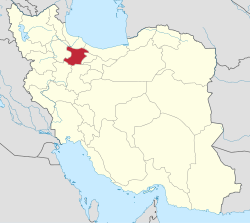
Aminiha Hosseiniyeh is a hosseiniyeh in the Akhund (Molavi) neighbourhood of Qazvin, Iran. Built in 1858, it comprises 16 interconnected structures.
The section under the halls comprises sectors such as the cellar, basement, store room, and kitchen which have access to the northern and southern courtyard. The north facing wall of the southern courtyard is of stone with innumerable embossments. [1]
